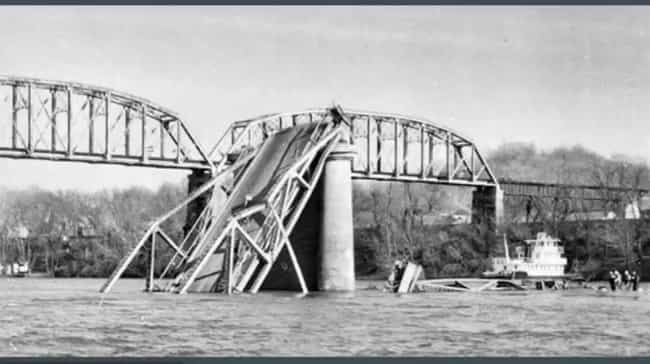The Mothman of Pleasant Point, West Virginia.
by
John William Tuohy
Point Pleasant, West Virginia, is a wonderful little town that sits on a point where the Ohio River joins the Kanawha River.

The Battle of Point was fought here in 1774 between the Royal Virginia Militia (West Virginia was once part of Virginia) and the local Indians.
October 10, 1774, some 1,100 Virginia militia led by Col. Andrew Lewis defeated 300-500 Shawnees and Mingoes led by Chief Cornstalk, a prominent leader of the mighty Shawnee nation. (His Indian name was Hokoleskwa, which, loosely translated mean “A stalk of corn”)
Cornstalk opposed European expansion west of the Ohio River. However, at the treaty of Fort Stanwix in 1774, the Iroquois had agreed to cede the lands south of the Ohio River in present-day West Virginia and Kentucky, but the Shawnee and others had not been present at the Fort Stanwix negotiations and when Europeans (White settlers) started to move into the area, bitter clashes followed.
The commander of the Virginia forces, Andrew Lewis, was born in Donegal Ireland but the family fled there in 1732 when his father, John Lewis murdered his landlord in a dispute over rent.
The Lewis’s became the first European settlers in western Augusta County. Andrew Lewis, trained as a surveyor, eventually helped to found Liberty Hall (Today’s Washington and Lee University) He and his father surveyed and explored much of Greenbrier County, Virginia. Lewisburg, West Virginia is named for him as is the Tri-State Area Boy Scout’s Council camping area in Ona, West Virginia.
Cornstalk’s forces attacked Lewis’s encampment starting a battle that lasted for hours and was finally reduced to hand-to-hand combat. Lewis managed to send several platoons up a nearby creek to attack the Shawnee from behind, breaking their ranks.
When the battle was over the Militia lost 75 men and suffered 140 wounded. The Indians carried away their dead and tossed them into the river, but the Colonials discovered almost thirty dead braves later in the day.
Cornstalk retreated and reluctantly accepted the Ohio River as the boundary of Shawnee lands in the Treaty of Camp Charlotte. At the treaty Virginia officer, Col. Benjamin Wilson, wrote of Cornstalk's speech to Lord Dunmore at Camp Charlotte in 1774: "I have heard the first orators in Virginia, Patrick Henry, and Richard Henry Lee, but never have I heard one whose powers of delivery surpassed those of Cornstalk on that occasion."
In 1908, the U.S. Senate declared the battle Point Pleasant was the first war of the American Revolution because the battle probably prevented an alliance of the British with the Shawnees Indians when the long-expected revolution did come around.
As for Cornstalk, the fall of 1777, he paid a diplomatic visit to Fort Randolph, a Colonial fort in Point Pleasant. The fort's commander arrested him and tossed him into the brig. On November 10, militiaman from the fort were killed, brutally, by Indians, it has never been made clear what tribe they from. In an act of mindless retaliation, the commander executed Cornstalk, his son Elinipsico, and two other Shawnees.
The executions caused ripples across the Colonies since the Americans believed that Cornstalk was their only hope of securing Shawnee neutrality. Virginia Governor Patrick Henry called Cornstalk's killers "vile assassins" and had them arrested and tried for murder. They were acquitted.
Cornstalk was originally buried at Fort Randolph but in 1840 Cornstalk his remains were moved to the Mason County Courthouse grounds. In 1954 the courthouse was torn down and he was reburied in Point Pleasant.
Point Pleasant is also known for being the town visited by an insectoid flying creature with bright red eyes who resembled both a moth and a man. Some claim the creatures origins are supernatural, others say it’s an alien, or government experiment gone wrong or perhaps a previously unknown species of animal Some locals said that the Moth Man was revenge from Cornstalk.
On November 17, 1966, a Wednesday, Steve Mallette, 20, and his wife of five months, Mary, and another young married couple, Roger and Linda Scarberry, were out for a ride and had just driven past a former a munitions production and storage site converted into a 2,500 acre McClintic Wildlife Station, a wildlife reserve, about five miles outside Point Pleasant. It was around midnight
"We came over a little rise in the road out near the old power plant when we saw the eyes over in the bushes. They glowed red and were six inches apart," Mallette said, a life-long hunter. He knew it wasn’t a raccoon or another animal.
Mallette sped the car through a maze of dirt roads and fishponds. "When we reached the paved road there it was again sitting on the bank across the road" Mallette added saying that they now saw that the creature had a man-like form. It stood over six feet tall, its wings protruding from the center of its back "like an angel." torso resembled a human except it had no arms and the face was hard to distinguish. It walked clumsily, "like a penguin," up."
The two women burst into tears as the group sped out of woods. "I'm not one to scare easy," Roger Scarberry said, "but I was for getting out of there."
But as they drove out, at speeds of up to 100 and 105 mph, the creature hovered above the car, casting a dark shadow over the rear window. "I was doing 100-105 mph and it was just gliding over top, sorta moving from side to side You could hear a flapping noise Then it came down at the car making a squealing noise like a mouse," Scarberry said.
They raced to the police station and returned to the preserve where they had seen the creature and deputy Millard Holstead watched "shadows circled the building" but added the sight “could have been the bird."
The couples offered to take lie-detector test. Mary Mallette said "We understand people are laughing at us. But we wouldn't make up all this to make us look like fools." A small armed posse of deputies, city police and others searched an abandoned building, a former power plant, in the preserve and spotted oval-shaped footprints measuring about 4% inches across and fresh animal droppings none of the natives in the party could identify.
Then it was learned that the night before the sighting, November 12, 1966, five men who were digging a grave at a cemetery near Clendenin, West Virginia, claimed to see a man-like figure fly low from the trees over their heads.
That same evening, contractor Newell Partridge, who lived g in a rural part of the county, told police that he was watching television at about 9:00 PM when suddenly the set omitted a loud screech and the burst apart. He said that immediately afterward he heard odd noises out in his yard and went to investigate, and his flashlight beam caught a couple of glowing red discs that he assumed were eyes from some sort of creature that was chased off by his German Shepherd, but the Shepherd disappeared as well, never to be seen again. Partridge said that when he aimed a flashlight at the creature its eyes glowed "like bicycle reflectors."
Dozens of people flooded into McClintic Wildlife station to catch a glimpse of the monster. Two of those people were volunteer firemen Captain Paul Yoder and Ben Enochs who actually did see something. They reported that they saw an extremely large bird with large red eyes fly away from them. Another local man shot a large Snowy Owl, which he maintained had been the source of the trouble
That sighting brought in Dr. Robert L. Smith, associate professor of wildlife biology at the University of West Virginia. Smith concluded that the creature flying around Point Pleasant was actually a sandhill crane, the second largest American crane, which stands almost as high as a man and has a wong span of more than seven feet. He said the "red eyes" could the large circles of bare reddish flesh around the crane's eyes. Smith said the bird appeared to have wandered out of its normal migration route and was resting in the Wildlife Area. The crane was unrecognized because it was not native to the region.
Joe Nickell, an author and investigator with the Committee for Skeptical Inquiry has looked into the case and has determined that the Mothman was more than probably an owl. “I think to do this, you have to take people at their word,” he says. “You take people’s description—allowing for some error—and match it to a real animal in the real world.”
Nickels says that the Moth man’s shape was originally reported is very owl-like, with a head and body that blended together. Yet as Nickell investigated, he became less convinced that a Barn Owl was the answer. Linda Scarberry, one of the women in the original car, had reported seeing huge, glinting red eyes in the car headlights, a description backed up by following sightings. That sounded like the product of eyeshine, a feature found in nocturnal animals like dogs, cats, alligators, and owls. However, Barn Owls have a relatively weak eyeshine but the Barred Owl, a large species, does have considerable eyeshine. What’s more, the McClintic Wildlife Management Area had a large population of Barred Owls live on the refuge.
There were other sightings over the next few months which added to the legend. Now, the story went, glowing lights in the sky appeared just before someone saw the Moth man as the creature was now called. Televisions and automobiles malfunctioned during the sightings, farmers reported cattle mutilations and peculiar and mysterious "men in black" dressed in clothing 30 years out of style, olive-skinned, unfamiliar with eating utensils, and unable to blink came to town and menaced witnesses. Mason County Sheriff George Johnson commented that he believed the sightings were due to an unusually large heron he termed a "shitepoke".
Frequent reports said that the creature seemed protective of children but devoured dogs. There was a theory that the creature was a mutant bird created by radioactive debris from the former mutinous plant. Reporters from the national and international news combed the city to look for evidence of the supernatural. The collected Mothman stories became a bestselling book, The Mothman Prophecies, and a feature film with the same name.
A large number of hoaxes followed the publicity generated by the original reports. In one case, a group of construction workers who tied flashlights to helium balloons. Others sightings were probably pranks, misidentified planes, and sightings of a barred owl, and albino owl.
The stories came to a halt several months later when, on December 15, 1967, the towns primary bridge, the Silver bridge (It had been painted silver) collapsed, killing 46 people.

Most recently, on November 23, 2016, a man driving along State Route 2 in West Virginia near Point Pleasant, said that he snapped pictures of the creature. There are no other details of the picture other than it was taken with a cell phone. Skeptics think that what the photo shows is a bird, perhaps an owl, carrying a frog or snake away.
However, the people of Point Pleasant were about to let the Mothman fade into history. Each September, starting in 2002, the town holds the annual Mothman festival. They built a 12-foot sculpture of the Mothman, based on eye-witness descriptions and even a Mothman museum.


















































